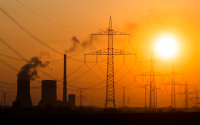30 August 2006Peter Boehm
As a Pacific island destination, Lateu struggles to sell itself. A typhoon wiped away its only beach a few years ago and today a handful of squalid thatched huts stand forlornly on its coastline. It will soon be a deserted village, its population the first real victims of rising sea levels brought about by global warming.
Even the village's palm trees are dying, their roots washed away by inexorably rising seas. The roofs of its thatched huts are leaking, there are gaping holes in the palm frond walls. All that remains of several are a few pathetic looking poles, braced against the prevailing wind from the vast expanse of the Pacific.
Lateu's people don't bother to patch their huts anymore, and an unpleasant mould covers the ground of every dwelling as a result of frequent flooding. For a while the islanders tried to rise above the surging seas by putting their huts up on makeshift foundations of coral, but they soon gave up. Now they are preparing to move to higher ground, some 300 metres inland, where they have already built six communal structures with financial aid from Canada.
Lateu is the only village on Tegua island, a half-moon-shaped speck of land less than four miles long and 10 miles wide in the South Pacific. It is one of five coral atolls in the Torres Group, 650 miles north of Vanuatu's main island, Efate. Getting here involves a flight in a small plane that goes once a week to the Torres' main island, Loh, and a prohibitively expensive, wet and frightening 40-minute ride over the open sea in a fisherman's boat.
The impact climate change has had on Tegua atoll is hard to ignore. Everywhere on the windward side of the island, palm trees are immersed by the sea. Some have survived the ordeal, others have fallen, littering the shallow waters of the coast line. "At the end of the Eighties, our village was flooded for the first time," says Reuben Seluin, 63, Lateu's village head. "Nowadays it happens every other month."
When the islanders resettled Tegua in the Sixties, they built Lateu directly next to the bay. During low tide, a tiny pond of sweet fresh water appears between the sea's coral ground. The pool gave Lateu its name. Aside from a rain water tank, the only thing Vanuatu's administration ever built on this island, it used to be the only source of drinking water for the atoll. Now the women use it to do their laundry.
During high tide, waves crash on a low pile of coral that separates the village from the sea, but Mr Seluin says that Lateu used to have a white sand beach. Part of it, he says, was washed away by a tsunami, triggered by an earthquake on Torres in 1997. "With every big tide that followed, the sea came a bit closer. I can't tell you whether this is due to climate change. I just know that we used to have a beach, and that it's gone."
The effects of climate change and rising sea levels can be seen on many islands in Vanuatu. In 1993, Australian scientists set up the Sea Level and Climate Monitoring Project. They recorded the sea level at 12 points in the South Pacific and detected a rise of, on average, 6mm per year, or 7.8cm (3.1 inches) in total. Vanuatu's Meteorological Department monitors the number of storms that have hit the nation since 1941. In the Forties, says the department's head, Jotham Napat, the number in their records was five, but in the past few years, the average has been 15.
Some climatologists, such as Stephen Koletti from the University of Southern California, say it is still too early to jump to conclusions. He warns that washed out beaches alone are not sufficient evidence for a rise in the sea level. "The ocean and the beach are part of a dynamic system," he says. "During the storm season, the ocean washes out the beaches, while in the summer they are replenished." But the fact that the coastlines of Vanuatu don't seem to recover has worried him.
Mr Seluin is not interested in the intricacies of scientific climate discussions, and when he recounts Tegua's fate, there is no bitterness in his voice. No, he is not angry, he says while thoroughly examining a shell on the ground in front of him, when it is put to him that the pollution in the developed world is responsible for the rise in sea level but the impact is felt on their island. He mumbles eventually: "I would never say something like that."
Life is not all bad on this tiny atoll. It is after all remarkably fertile. The islanders grow fruit and vegetables in their plots of land in the rainforest, a half hour walk straight up the hill. If they want meat with their meals, they go for walk to pick up some crimson-coloured homade crabs, or, a little deeper into the forest, coconut crabs, which are a sought-after delicacy in restaurants of far-away Port Vila, on Efate. When the sea is calm, they go fishing in crudely carved dugouts, or dive at night with a waterproof flashlight to rouse some lobsters.
From time to time, a group of four to six paddle two hours in their kayaks to the main part of the island to sell a few coconut crabs and buy merchandise such as matches, batteries, and other material. Little else gets through to Tegua. One islander owns a shortwave radio. A one-man news agency, if he hears something interesting, he spreads the news. Neither the World Cup nor the war in Lebanon made the cut.
Mr Seluin's feet look wide and flat, from walking barefoot his whole life. He sports the same washed-out shorts every day and a T-shirt with the slogan: "Life's a bitch... And then you dive."
The crew of a passing yacht donated it to him a few years back. Mr Seluin is not only the head of administration, the sole policeman, and only judge of the island, he is the clan chief as well, because all of the 60 inhabitants on Tegua belong to one extended family. Aden Seluin, the village head's eldest son, mans the tiny health station. With its shiny blue wooden walls, it comes closest to what a regular house looks like. Anyone suffering from something more severe than malaria has to be taken to the main island.
Godwin, Seluin's middle son, acts as a catechist for the small Anglican church in Lateu. He says that when a government delegation came to Tegua in 1998 and told them that the flooding was due to global warming, the pastor from the main island joined them. "He wanted to give us some comfort. We were really shocked. He told us that, yes, we were experiencing climate change, but that God would help us and not everybody was going to die."
When the islanders go to their gardens in the morning, they leave their children with Bettina Seluin, the village head's niece, in Lateu's tiny kindergarten.
As the children play with cardboard toys, she says: "In school we were never told about climate change. Because of the tsunami, a government delegation came to Tegua. That's when we heard about it for the very first time."
The government delegation that visited Tegua in early 1998 actually came because Vanuatu had become eligible for relief funds, having just signed the United Nations Framework Convention on Climate Change. Delegations visited all of Vanuatu's 83 islands to assess what impact global warming had had and would be likely to have in the future. That is how they learned about Lateu's plight.
After the tsunami, the villagers had decided to move their village inland, and the administration agreed to use part of a Canadian relief fund to support them. They settled for a clearing 300 meters inland, but up a steep hill from their old village, Lirak. With $50,000 (£27,000), they built six shacks. They will drink rain water, collected from the roofs of the communal buildings, and they will get a satellite-based radio system, through which the Meteorological Department will send weather updates.
Only two families have built their private huts in Lirak so far. Titus Woilami, the village head's brother-in-law, with his wife and four daughters, is one of them. He says: "During full moon and new moon Lateu was always in danger. Then we have king tides. That really put a strain on me. I could barely sleep, because it constantly swirled around my head: Will the water run into our hut again?"
The village head says moving the whole village with the church, kindergarten and health station will take a few more months. He is, of course, grateful for the new communal buildings. "Everything we ever owned, we put into Lateu," he says. But his clan will not leave Tegua. "We love our island. We have our gardens, we have fish in the sea, we have crabs to feed us. It doesn't matter that we don't have a radio, or a boat. We will stay here."
http://news.independent.co.uk/environment/article1222595.ece






